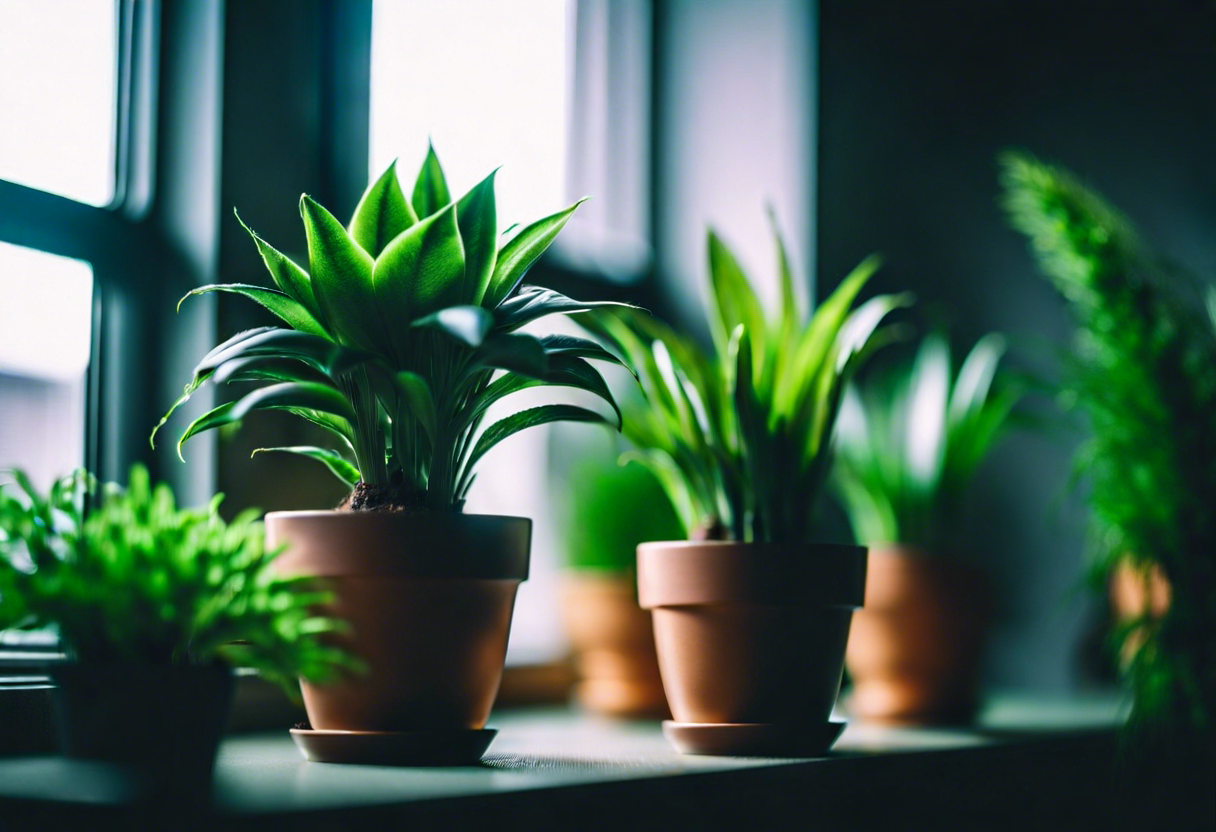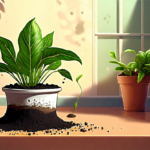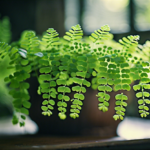Benefits of Having Indoor Plants in Your Home or Apartment
Indoor plants not only enhance the aesthetic appeal of your home or apartment but also provide numerous benefits to your overall well-being. The presence of greenery indoors can have a positive impact on both your physical and mental health. Here are some of the key advantages of incorporating indoor plants into your living space.
1. Improved Air Quality: One of the most significant benefits of indoor plants is their ability to purify the air. Through the process of photosynthesis, plants convert carbon dioxide into oxygen, leading to a healthier breathing environment. Additionally, certain indoor plants, such as the snake plant or peace lily, have the ability to remove harmful toxins like formaldehyde and benzene from the air, promoting better indoor air quality.
2. Enhanced Well-being: Research suggests that being surrounded by nature, even indoors, can have a positive impact on your mental health and well-being. Indoor plants can help reduce stress, enhance mood, and create a calming ambiance. Their presence can provide a sense of tranquility and relaxation, making your home a more peaceful and inviting space.
3. Increased Productivity: Indoor plants can also boost productivity levels, whether you’re working from home or studying. Studies have shown that having plants in your immediate vicinity can improve focus, concentration, and creativity. The visual appeal of greenery can help reduce mental fatigue, ultimately leading to enhanced productivity and efficiency.
4. Sound Absorption: Certain indoor plants, such as the Boston fern or rubber plant, have the ability to absorb sound, making them ideal additions to homes or apartments located in noisy environments. By reducing background noise, these plants create a more peaceful and serene indoor atmosphere, allowing you to relax and unwind.
5. Natural Humidifiers: Indoor plants release moisture vapor through a process called transpiration, which helps increase humidity levels in the surrounding area. This can be particularly beneficial during dry seasons or in spaces where indoor heating systems tend to dry out the air. By acting as natural humidifiers, plants can prevent issues like dry skin, irritated throat, and respiratory problems.
Indoor plants into your home or apartment offers a myriad of benefits, including improved air quality, enhanced well-being, increased productivity, sound absorption, and natural humidity regulation. Choose the right plants for your space and experience the beauty and advantages of bringing nature indoors. So why wait? Start creating your own green oasis today!
Benefits of Having Indoor Plants in Your Home or Apartment
Low Maintenance Indoor Plants for Busy Individuals
Having indoor plants is a great way to incorporate nature into your home or apartment. Not only do they enhance the aesthetic appeal of your space, but indoor plants also offer numerous benefits for your health and well-being. However, for busy individuals who struggle to find time for plant care, it’s essential to choose low maintenance indoor plants that require minimal effort and attention.
One great option for low maintenance indoor plants is the Snake Plant (Sansevieria). This plant is known for its ability to thrive in various lighting conditions, whether it’s bright light or low light areas. Snake plants also have a unique quality of converting carbon dioxide into oxygen during the night, making them ideal for bedrooms or spaces where fresh air is desired. Additionally, they don’t require frequent watering and can withstand periods of neglect.
Another excellent choice is the ZZ Plant (Zamioculcas zamiifolia). This plant is known for its impressive tolerance to low light conditions and irregular watering. The ZZ Plant has shiny, dark green leaves that can brighten up any space while requiring minimal care. It’s an excellent option for busy individuals who often forget to water their plants consistently.
If you’re looking for a cascading plant that adds beauty to your space without much maintenance, the Devil’s Ivy (Epipremnum aureum) is an excellent choice. This plant thrives in bright, indirect light but can also survive in lower light conditions. Devil’s Ivy is easy to care for and can tolerate occasional missed waterings. Its trailing vines make it perfect for hanging baskets or placing on shelves, adding a touch of greenery to your interior.
For those looking for a touch of color and fragrance, the Peace Lily (Spathiphyllum) is an ideal option. This plant is known for its beautiful white blooms and glossy, dark green leaves. Peace Lilies thrive in low to medium light environments and only require watering when the soil feels dry. Additionally, they are excellent air purifiers, helping to improve the overall air quality in your home or apartment.
To add a tropical vibe to your space, consider the Parlor Palm (Chamaedorea elegans). This plant is versatile and can tolerate low light conditions while still thriving. The Parlor Palm requires minimal care and only needs watering when the soil feels dry to the touch. Its lush green foliage adds a refreshing touch to any room and serves as a natural air humidifier, benefiting your overall well-being.
If you lead a busy lifestyle but still want to incorporate indoor plants into your home or apartment, there are plenty of low maintenance options available. Snake plants, ZZ plants, Devil’s Ivy, Peace Lilies, and Parlor Palms are just a few examples of indoor plants that thrive with minimal care. So go ahead and bring nature indoors, even if you have a busy schedule. Your space will look beautiful, and you’ll enjoy the benefits of having these green companions around you.
Best Indoor Plants for Small Spaces or Apartments with Low Light
Living in a small space or apartment doesn’t mean you can’t enjoy the benefits of indoor plants. In fact, there are plenty of indoor plants that thrive in low light conditions and are perfect for adding a touch of greenery to your living space. Whether you have limited sunlight or small windows, these plants can survive and even thrive in low light environments. Here are some of the best indoor plants for small spaces or apartments with low light:
Spider Plant (Chlorophytum comosum)
The spider plant is a popular choice for indoor gardening enthusiasts, and it’s easy to see why. This plant is known for its long, arching leaves that come in various shades of green and white. Spider plants are great for small spaces because they don’t take up much room and can be easily placed on shelves or in hanging baskets. They also tolerate low light conditions, making them a perfect choice for apartments with windows that face north or don’t get much direct sunlight.
Peace Lily (Spathiphyllum)
The peace lily is not only a beautiful plant but also a great air purifier. It’s known for its elegant white flowers that bloom throughout the year. Peace lilies can thrive in low light conditions and only need to be watered once a week, making them a low maintenance choice for busy individuals or apartments with limited natural light.
Pothos (Epipremnum aureum)
Pothos, also known as Devil’s ivy, is a versatile plant that can survive in various lighting conditions, including low light. It has heart-shaped green leaves and can be placed on a tabletop or hung in a hanging basket. Pothos is known for its ability to purify the air and help remove harmful toxins, making it an excellent choice for improving indoor air quality.
ZZ Plant (Zamioculcas zamiifolia)
The ZZ plant is a very resilient plant that thrives in low light conditions. It has glossy, dark green leaves that add a touch of elegance to any space. The ZZ plant is ideal for small spaces because it requires minimal care and can tolerate irregular watering. It’s also known for its air-purifying qualities, making it a popular choice for apartments with limited natural light.
Snake Plant (Sansevieria trifasciata)
The snake plant, also known as mother-in-law’s tongue, is a hardy plant that can thrive in both low light and bright light environments. It has long, upright leaves that are usually green with yellow edges. Snake plants are known for their air-purifying abilities and can help remove toxins from the air, making them perfect for improving indoor air quality in small spaces or apartments with limited natural light.
These are just a few examples of the best indoor plants for small spaces or apartments with low light. these plants into your living space not only adds a touch of nature but also provides numerous health benefits. So, don’t let limited light deter you from creating your very own indoor green oasis.
How to Choose the Right Indoor Plants for Your Home Décor
When it comes to decorating your home, indoor plants can be a beautiful and refreshing addition. They not only add a touch of nature to any space but also have numerous benefits for your overall well-being. However, choosing the right indoor plants for your home décor requires some careful consideration. Here are some tips to help you make the best choice:
Consider the lighting conditions: The amount of natural light your home receives is a crucial factor in determining the type of indoor plants that will thrive in your space. Different plants have different light requirements. If your home has limited natural light, opt for low-light plants like snake plant or pothos. On the other hand, if your home receives plenty of sunlight, consider plants such as succulents or peace lilies that thrive in bright conditions.
Assess the available space: Take a look at the available space in your home and consider the size of the plants you want to incorporate. If you have a small apartment or limited floor space, look for compact plants like bonsai or ferns that can be placed on shelves or tabletops. Alternatively, if you have larger areas to fill, consider tall plants like the fiddle-leaf fig or rubber plant to add height and drama to your décor.
Determine your care routine: It’s important to be realistic about the amount of time and effort you can invest in maintaining your indoor plants. Some plants require more care and attention than others. If you have a busy lifestyle or tend to forget watering your plants, choose low-maintenance options such as aloe vera or spider plants. These plants are more forgiving and can withstand occasional neglect.
Match plants to your décor style: Consider the overall style and theme of your home when selecting indoor plants. For a modern and minimalist interior, sleek and architectural plants like the ZZ plant or snake plant can complement the clean lines. If you prefer a more bohemian and eclectic look, opt for trailing plants like the pothos or string of pearls. Additionally, the color of the foliage can also be taken into account to create a harmonious palette with your existing décor.
Think about air purification: Indoor air pollution is a common problem in many homes. Certain indoor plants have the ability to purify the air by removing toxins and producing oxygen. If you are concerned about improving the air quality in your living space, consider incorporating plants such as the peace lily, spider plant, or Boston fern. These plants have been proven to effectively reduce indoor pollutants and create a healthier environment.
By considering factors such as lighting, space, care routine, décor style, and air purification, you can choose the perfect indoor plants to enhance your home décor. Whether you have a small apartment or a spacious home, there are indoor plants to suit every space and personal style. So go ahead, bring a touch of nature indoors and enjoy the many benefits that indoor plants have to offer.
The Best Air-Purifying Indoor Plants for a Healthier Living Environment
Indoor plants not only add beauty to your home or apartment, but they also have numerous health benefits. One of the key benefits is their ability to purify the air, removing harmful toxins and improving air quality. air-purifying plants into your living space can have a positive impact on your well-being. In this article, we will explore some of the best indoor plants for creating a healthier living environment.
-
Spider Plant (Chlorophytum comosum):
Spider plants are known for their ability to remove formaldehyde and xylene from the air. Their long, arching leaves make them an attractive addition to any space. Spider plants are also low-maintenance, making them perfect for busy individuals. -
Snake Plant (Sansevieria trifasciata):
Snake plants, also known as mother-in-law’s tongue, are excellent air purifiers. They convert carbon dioxide into oxygen during the night, making them ideal for bedrooms. Snake plants can also filter out formaldehyde, benzene, trichloroethylene, and xylene from the air. -
Peace Lily (Spathiphyllum):
Peace lilies are popular indoor plants due to their beautiful white flowers. Apart from their aesthetic appeal, they are renowned for their ability to remove ammonia, benzene, formaldehyde, and trichloroethylene from the air. Peace lilies thrive in low-light conditions, making them suitable for apartments with limited sunlight. -
Boston Fern (Nephrolepis exaltata):
Boston ferns are known for their lush green foliage and their excellent air-purifying capabilities. They help in removing formaldehyde, benzene, and xylene from indoor air. These ferns prefer high humidity, making them a great choice for bathrooms or kitchens. -
Aloe Vera (Aloe barbadensis):
Aloe vera is not only a popular plant for its medicinal properties but also for its air-purifying abilities. It helps remove formaldehyde and benzene from the air. Additionally, aloe vera emits oxygen at night, making it suitable for bedrooms. -
English Ivy (Hedera helix):
English ivy is a trailing vine that is easy to care for and has excellent air-purifying qualities. It can remove formaldehyde, benzene, xylene, and toluene from indoor air. English Ivy can be grown in hanging baskets, making it a space-saving option for small apartments. -
Areca Palm (Dypsis lutescens):
Areca palms are not only visually appealing but also possess excellent air-purifying properties. They effectively remove formaldehyde, xylene, and toluene from the air. Areca palms require bright, indirect sunlight, so placing them near a window is ideal.
Air-purifying indoor plants in your home or apartment can significantly enhance your living environment. These plants not only improve air quality but also add a touch of nature to your space. Choose the ones that suit your lifestyle and the specific requirements of your living area. Make your home a sanctuary of clean, fresh air by bringing in these best air-purifying indoor plants.
Conclusion
Incorporating indoor plants into your home or apartment has a multitude of benefits that extend far beyond just aesthetics. Not only do these green companions add a touch of nature to your indoor space, but they also provide a range of health benefits. For busy individuals who may not have much time to dedicate to plant care, low-maintenance indoor plants are the perfect choice. These resilient plants can thrive with minimal attention and still enhance the overall atmosphere of your living space.
If you have a small space or an apartment with limited natural light, there are various indoor plants that can thrive in such conditions. Opting for plants like the snake plant, pothos, or ZZ plant allows you to bring greenery into your home without the need for abundant sunlight. These plants can adapt to low light levels and still flourish, making them ideal choices for urban dwellers or those living in apartments with limited access to natural light.
When selecting indoor plants for your home décor, it’s crucial to consider the overall aesthetic you’re trying to achieve. Whether you prefer a minimalist style or a bohemian vibe, there are indoor plants to suit every taste and interior design. Plants like the fiddle-leaf fig tree, monstera, or succulents can add a pop of green while complementing your existing home décor elements. By carefully selecting the right indoor plants, you can create a harmonious and visually stunning living space.
In addition to their visual appeal, many indoor plants also have air-purifying properties, helping to create a healthier living environment. Plants such as the peace lily, spider plant, and Boston fern are known for their ability to remove toxins and pollutants from the air. By having these air-purifying plants in your home, you can significantly improve the air quality and reduce the risk of respiratory issues, allergies, and other health problems.
Incorporating indoor plants into your home or apartment can transform your living space into a green oasis while providing numerous benefits. Whether you’re a busy individual looking for low-maintenance plants, have limited natural light, or want to enhance your home décor, there are indoor plants suitable for every need. Moreover, selecting air-purifying plants can improve the overall air quality in your living environment, contributing to a healthier and more vibrant ambiance. So go ahead and invite nature indoors with the best indoor plants for any home or apartment, and enjoy the beauty and benefits they bring to your space.


